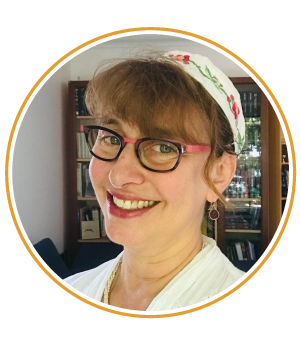 The ancient rabbis ask “Why was the world created with the letter bet?”
The ancient rabbis ask “Why was the world created with the letter bet?”
Here we go again…reading the same old Torah from the start with Parashat B’reshit. Haven’t we been here before? Don’t we know how it ends? Who can see the point in it? Honestly, if you’ve looked closely at a Torah, you know there is no point. No one can see any point in it, because the Torah scrolls we read have no “points” (know in Hebrew as nikudot).
Nikudot, or points, are the dot-and-dash-like vowel symbols guiding us to correctly blend Hebrew consonants into words or to distinguish sounds of closely related letters (like Bet and Vet). While some books for prayer, study or beginner Hebrew readers are “pointed” with vowels, most Hebrew books, magazines, websites and materials for the general Hebrew-reading population are “pointless.” Experienced readers decipher vowel-free Hebrew from context. So too, our ancient scrolls are “pointless.” The vowels, spaces and phrasing of contemporary Torah volumes were added to the flowing consonants by the Masoretes who began working around 600 C.E. After centuries of work, they completed their task near the end of the first millennium; chapter and verse enumeration emerged only in the Renaissance.
Until nearly 1000 C.E. the Torah didn’t have standard nikudot. In this consonant-only context, the ancient rabbis developed both a consistency of standard reading and a passion for close examination of every single Torah letter. Such close reading aligns with Rabbi Akiva’s teaching that there is no superfluous character in the Torah. This approach led the rabbis to seek meaning not only in Torah’s narratives, mitzvot, words and sound-symbols, but also in variant spellings and even in spaces between or within words and letters.
Perhaps the absence of cluttering dots and dashes helped clear the way towards an early rabbinic midrash about the shape of the Torah’s first letter. This week, reading the opening account of creation, we revisit the Torah’s first letter: bet. Bet, the second letter of our Hebrew alphabet, represents the number two. In the Masorete’s text, the letter has a single dot-point in the center. In all texts, the letter looks rather like a three- sided box, closed on the top, bottom and back.
In Bereshit Rabbah 1:10, the rabbis ask “why was the world created with the letter bet?”. Referring to the bet’s shape, the midrash explains that just as bet is limited above, we are limited in our knowledge of the heavens above us. As bet is bound below, so are we restrained from reaching the earth’s deepest depths. Similarly, like bet, we are barred from looking too far back; we cannot see what occurred in the earliest of times. B’reshit Rabbah teaches us that like the bet, we are restricted above, below and behind; if we want to make strides, the only way we can go is forward.
Unfortunately, even pressing forward is difficult in these times. Our children’s lives are unsettled and our elders are more isolated than ever. Relatives have lost jobs. Friends have battled COVID, and too often, it has prevailed. As I write, friends in Melbourne are in their 235th day of hard lock-down. We want to go forward, but reports of new variants, out-breaks, shifting restrictions, exhaustion and hopelessness get in our way. The hardships of COVID are compounded by the complexities of “normal” life. Pushing forward becomes more grueling as our expectations, hopes and dreams ebb, flow and fade. We know that like the Torah scroll’s first bet, looking forward is our only option, but too often we can’t see the point.
Unexpectedly, a blind rabbi of the Zohar offers us vision and insight which hits home. According to Kabbalah, Rabbi Rechumai was a remarkable elder whose “eyes transcended seeing”; he was physically blind. However, when his friend Rabbi Pinchas visited, the older sage recounted “gazing at light…issuing like the sun illuminating the entire world.” In the mystical text, as the two seekers converse and connect, Rabbi Rechumai describes his vision of light emanating from the younger man’s house like a “fine, threadlike ray, radiating and illuminating the entire world.” For years, Rabbi Pinchas’ family had known sickness and isolation, but Rabbi Rechumai seeing the light which was also present, declares “Happy is your share! Now go!” (Zohar 1:11b).
In this moment of connection, the blind man’s vision changes the sighted man’s perception. New energy flows from Rabbi Pinchas which he shares through the relationships he forges and renews while journeying home. We watch the younger rabbi and realize that his pivotal point of change was through shared time and conversation – in this case with his old, blind friend. Together with Rabbi Pinchas, we can make the connection: meaning is not derived from seeing the point, but from being the point. Each of us can fill at least some empty space as we consciously become points of contact and connection.
Points of connection may be as obvious as a call to a cousin or as masked as a middle-eastern meatball. In fact, my parents recently sent me a picture of beautiful steaming middle-eastern meatballs which a widowed neighbor in California dropped off for their dinner. The neighbor’s husband had been a beloved Palestinian Priest in the Antiochian Orthodox Church. He and my father often enjoyed exploring Jewish perspectives on the Bible…when my passed by with the dog on the daily walk. Eventually the neighbors’ daughter wanted to follow in her father’s footsteps and consider Bible from a Jewish perspective. In time, the she joined one of my Zoom Torah Study classes in which learners now discuss midrash, Hebrew grammar, Arabic letters and occasionally old family recipes for round challahs or rolling meatballs. Now, meatballs remind everyone in class of dots inside bets and points of connection.
Surprisingly, an Australian rabbi and a Palestinian Priest’s daughter become friends through bible study and neighborly connections. Sometimes, she checks in on my folks for me. Occasionally when I face-time my parents, I see her in my mom’s kitchen, visiting after dropping off some delicious dish. I wish I could be there. Unlike past years, COVID and local restrictions currently keep me out of my parent’s kitchen…and country.
Each new year bring unanticipated changes, both subtle and significant, to our abilities, our understanding and our connection to the “pointless Torah” we read yet again. Some years, we burst out of the Torah’s first bet ready to race into the future. Other years, the bet’s three sturdy sides provide needed stability allowing us to cocoon in its embrace. During these COVID years, we’ve sometimes felt confined by bet’s walls, lost or invisible in hopeless, bleak emptiness. These are the times to remember that bet represents two; when two people meet and create even a single kind point of connection, a spark of blessing shines, reflecting the Light of the Holy One for an instant… or an eternity.
As we begin Bereshit anew, may we be open to bright futures. May we know, with certainty, that just as the sun rises each day and the stars sparkle each night, light and connection are ready to be revealed with each rotation of the earth. May we be blessed and may we create blessings through points of connection each and every day of our lives.

The views and opinions expressed in this article are those of the author(s) and do not necessarily reflect the official policy or position of the World Union for Progressive Judaism (WUPJ).
